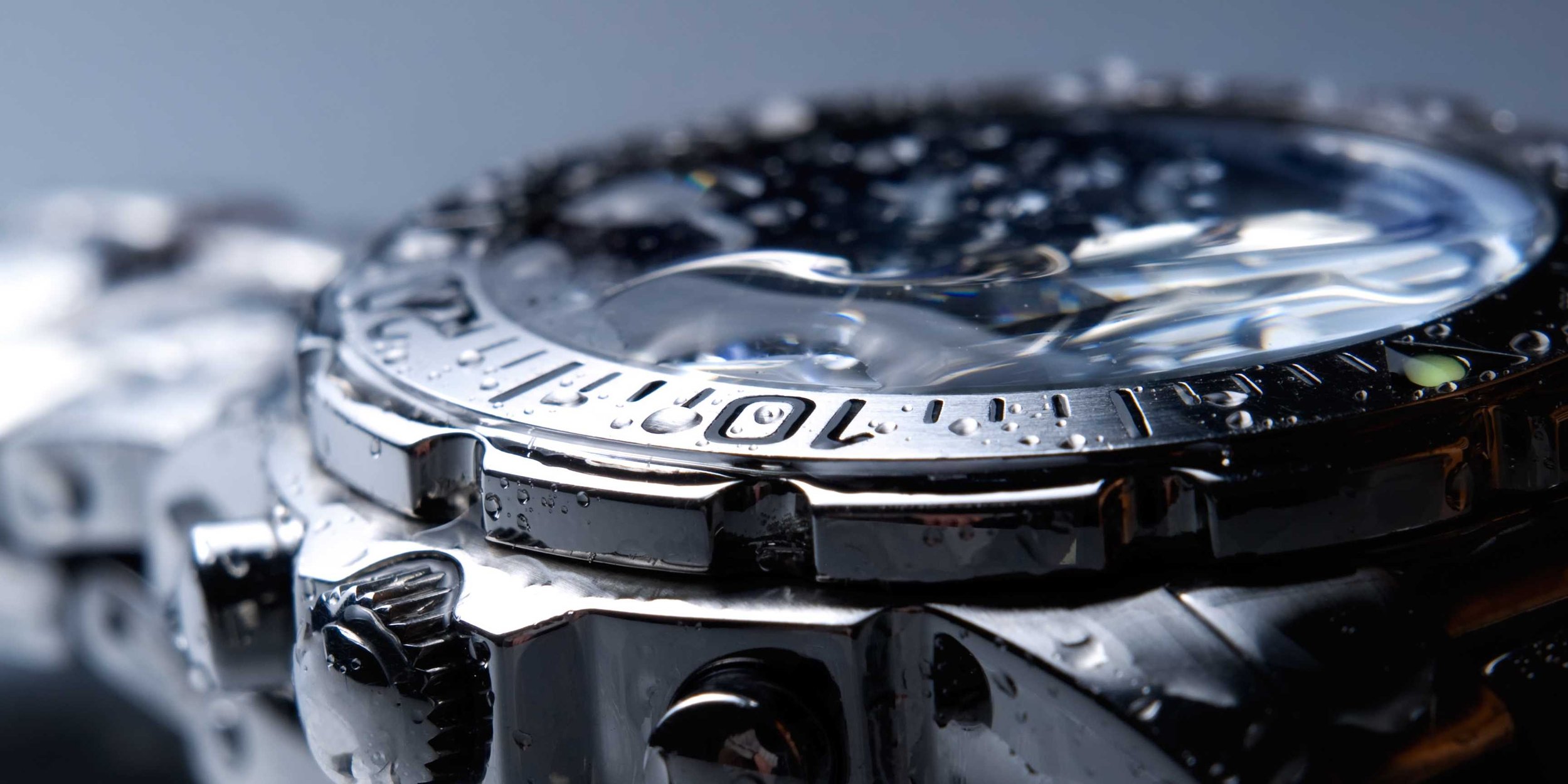Water Damage: What to do if your watch gets wet?
Last updated on the 15th of May 2023 by Huxley Mann.
H2-oh-no! Has your watch been exposed to water? Well, don't dispair. Water damage is one of the most common reasons for a timepiece to stop functioning, which, if left ignored, can lead to extensive repair costs. Knowing what to do when your watch gets wet is the key to minimising any water-related damage and getting your timepiece back up and running.
Below we will discuss what causes water damage, preventive measures you can take, how to identify if your watch's mechanism has been exposed to moisture and how to reduce further damage from occurring.
Waterproof vs water resistant
What does it mean for a watch to be waterproof?
The term 'waterproof' is slightly misleading. When a watch is labelled as waterproof, it means it has been specially designed to be water-resistant to a specific depth, such as 30 metres/100 feet or 50 metres/165 feet. However, this can vary depending on the make and model of the watch. Sadly, under certain circumstances, anything can leak, which is why we refer to a watch's ability to withstand water pressure as water resistance in the watch industry.
What does it mean for a watch to be water resistant?
Watches labelled as "water-resistant" are often humidity protected and can withstand being caught out in the rain and the odd splash of water whilst you are washing your hands, for example. However, unlike waterproof watches, they should not be submerged in water.
How can you tell if a watch has water damage?
Several telltale signs indicate a watch may have water damage, including:
Discolouration, corrosion and rusting on the hands and dial
Fogging or condensation in the crystal
Fluid stains in the case back seal
Odour coming from the watch
If you notice any of these signs, it's imperative you take your watch to a professional watch repair shop for inspection to minimise any further damage to your timepiece.
Although externally, your watch might look perfectly normal, sadly, once the water has entered your timepiece, it can cause untold damage to the delicate components inside.
What causes water damage in a watch?
The cause of water damage in a watch isn't limited to submerging your timepiece in water for extended periods. Instead, water can infiltrate your watch's delicate mechanism in several different ways:
Condensation
Condensation occurs when humid air comes into contact with the cold surface of a watch's crystal, which causes the water vapour present in the air to condense and form droplets on the watch's glass surface. If this occurs, wipe the droplets off with a soft dry cloth.
If your watch is inadequately sealed, moisture can become trapped inside the case, forming droplets that drip down to your watch mechanism, leading to corrosion and rusting of internal components.
Broken seals
Several features make a watch water-resistant. The most important are the silicon or rubber hoops, called gaskets, that sit inside the case, crystal, stem, crown, and pushers to form a waterproof seal around the important mechanisms within.
Watch gaskets are prone to wear and tear, compromising their effectiveness over time. Additionally, they can degrade due to exposure to extreme temperatures and certain chemicals.
If a gasket is broken or damaged, the waterproof seal created by the gasket is compromised, which can allow water to seep in and damage the watch's internal components.
Damaged watch glass
A damaged watch glass can result in water damage if it fails to provide a waterproof seal. Small cracks, scratches or chips in the watch glass can reduce its ability to resist moisture, allowing water to seep in and cause damage to the internal components of your watch. Additionally, condensation can form inside the watch case due to temperature fluctuations, which can cause corrosion and potentially damage the electrical components of a quartz timepiece.
Sweat
Sweating is a natural and healthy response of our body. But sadly, through regular wear, sweat can affect the water-resistance of our watches, leading to water damage.
Sweat is composed of water, salt and other minerals, which over time, can corrode the external and internal parts of your timepiece and cause condensation to form.
To avoid having your timepiece's water resistance compromised or water damage caused by sweat, remember to wipe your watch with a dry cloth after use and remove it before exercising or any activity that causes heavy sweating.
Accidents happen
Whether you forgot to take your watch off before having a shower, one of the kids spilt a drink over it, or maybe you dropped your timepiece and damaged the case, accidents happen at the end of the day.
If you believe that your watch has been exposed to water or if you have somehow compromised its water resistance, we recommend you take your timepiece to a professional watch repair centre for examination to prevent any further damage from occurring, which could cost you more in the long run.
What to do if your watch gets wet?
Remove any excess water.
If the watch gets wet, immediately dry it with a soft cloth and try to remove as much moisture as possible.
Use absorbents
A method you can use to dry out your watch is by putting it inside an airtight container with some silica gel and leaving it there for 2-3 days. However, you do run the risk of not fully removing all the moisture from your timepiece, leading to further corrosion and damage.
Don't fiddle with your watch
Do not use, wear, press any buttons or tamper with any parts of a water-damaged watch. Doing so can result in short circuits or other electric damage, leading to further complications and reducing the chances of a successful repair. Additionally, if the water contains particles such as sand or dust, pressing buttons can push these particles inside the mechanism and cause further damage.
Do not heat your watch up.
An attractive idea might be to place your watch on a radiator or use a hair dryer to dry out your timepiece. However, we strongly advise against this as it can actually cause greater damage!
Exposing your quartz or battery-powered watch to high temperatures can cause a chemical reaction in the battery, which may result in swelling and leakage of dangerous corrosive substances that will damage other aspects of your watch's delicate mechanism.
Heating up a watch can also damage the gaskets and cause the delicate internal moving parts of the timepiece to expand and contract, potentially damaging them irreversibly. Additionally, high temperatures can dry out the lubricants inside the watch, making it less efficient over time and reducing its ability to keep accurate time.
Furthermore, extreme heat can also warp or discolour the face of the watch, affecting its appearance.
How do I keep moisture out of my watch?
Water damage can be a nightmare for watch owners, but there are some simple steps you can take to avoid it. Here are some tips on how to keep your timepiece safe from water damage:
Check the water resistance rating: Before exposing your watch to water, check its water resistance rating. This information can usually be found on the case back or in the user manual. If your watch is not rated for water resistance, don't expose it to water.
Have your watch pressure tested: it's essential to have your timepiece pressure tested to ensure the water-resistant capabilities of your watch to the manufacturers' specifications. You will also receive a test report that your timepiece has passed.
Avoid extremes of temperature: Rapid temperature changes can cause condensation to form inside your watch, which can lead to water damage.
Keep the crown and buttons closed: When wearing your watch around water, make sure that the crown and buttons are screwed down tightly.
Rinse your watch after exposure to saltwater: Saltwater can damage your watch's finish and cause corrosion. So, if you've been swimming in saltwater, rinse your watch with fresh water afterwards.
Regular maintenance: Having your watch serviced regularly can ensure that all the seals in your timepiece are in good condition. During the service a watchmaker will be able to detect any signs of water damage early on and prevent further damage.
By following these simple steps, you can help prevent water damage to your timepiece and ensure that it stays looking great and running smoothly for years to come.
Can a watch be fixed after water damage?
The good news is most water damage is usually reversible, but it's essential to take action quickly. Avoid panicking and attempting to fix your timepiece yourself using untested methods. Instead, we'd recommend you take your water-damaged watch to an experienced watch repair shop. Even if your watch appears to be working, there still may be unseen internal damage that can worsen over time resulting in additional costly repairs.
How can we help?
At AMJ Watch Repair, our watchmakers have decades of experience working with a wide array of quartz, automatic and mechanical watch models.
Using the latest equipment and tools, our technicians will quickly and efficiently find the most affordable method to restore your water-damaged timepiece to perfect working order.
You are more than welcome to drop by our watch repair shop, located in the heart of London's historic jewellery district Hatton Garden OR why not send us your watch in the post?




